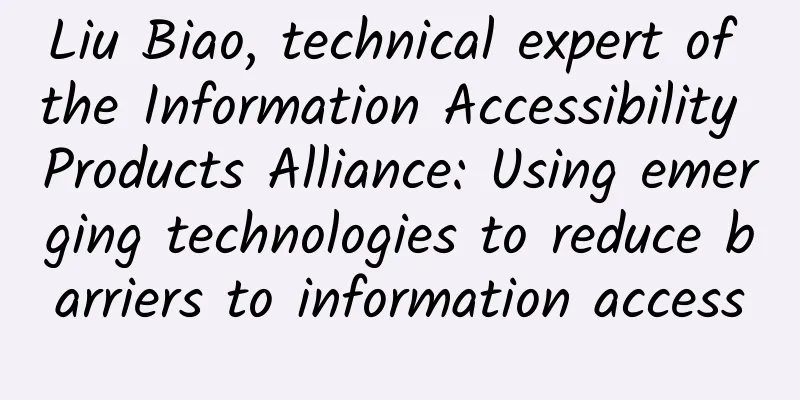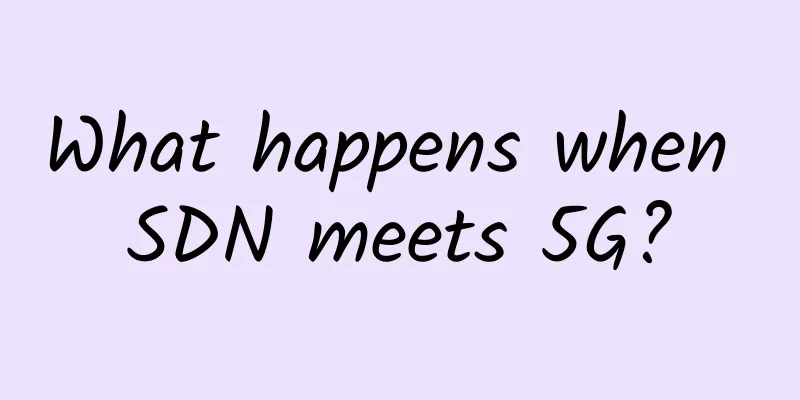Liu Biao, technical expert of the Information Accessibility Products Alliance: Using emerging technologies to reduce barriers to information access

|
[51CTO.com original article] When people use various popular Internet devices, few people may think that there are actually a group of people around them who have many obstacles in obtaining information for various reasons and need to be "treated specially". Don't think that this is just an isolated phenomenon. In fact, in China, there are 130 million elderly people over 65 years old, 13 million visually impaired people, 20 million hearing impaired people, and 70 million people with dyslexia - a total of about 20% of China's population. In other words, more than 200 million people with information accessibility barriers are ignored by most domestic Internet products. Facing this group, "information accessibility" becomes particularly important. The concept of "information accessibility" originated in developed Western countries. It is translated from "Accessibility" and means that anyone can obtain and use information equally, conveniently and without obstacles under any circumstances. Taking the Internet environment as an example, Internet products can be smoothly used by users such as the elderly, the visually impaired, the hearing impaired, and the dyslexic by optimizing ease of use and availability. At the same time, they can be used more efficiently and conveniently by all users. On December 1, 2017, at the main venue of the WOTD 2017 Global Software Development Technology Summit hosted by 51CTO, Liu Biao, a technical expert from the Shenzhen Information Accessibility Research Association/Information Accessibility Product Alliance, gave a wonderful speech entitled "Front-end Information Accessibility Technology and Framework". He interpreted and shared the current status of China's information accessibility from a technical perspective. The reporter also interviewed him at *** time and asked him to talk about how to meet the information needs of this special group.
51CTO reporter: As smart terminals become more and more abundant, people have more and more ways to obtain information. Do you think this is a good thing or a bad thing for barrier-free access to information? Liu Biao: I think this is a good thing, because the emergence of new ways to obtain information means the improvement or elimination of certain obstacles in the current way of obtaining information. For example, voice interaction technology, including voice text entry and voice recognition, solves the inconveniences that people used to have. When people control devices through voice, the efficiency of visually impaired people and ordinary people is almost the same. This eliminates obstacles for people with disabilities and improves efficiency for healthy people. Of course, new obstacles are likely to arise in newly emerging interaction modes, which also need to be continuously improved and resolved. 51CTO reporter: In your previous work, what do you think is the main difficulty in barrier-free access to information? What do you think is the main value of the service it provides? Liu Biao: This work does have many difficulties. The biggest problem is that the number of people with information accessibility issues is not taken into consideration at the beginning of product design. Often, a large amount of feedback is received only when the product is in use, reminding designers that it is difficult to obtain information. Secondly, the interactive methods of the domestic mobile Internet are constantly changing and updating, and the usage environment is becoming more and more complex. This also poses a great challenge to information accessibility - how to make these ever-changing interactive methods able to be used smoothly by different groups of people. 51CTO reporter: How did you first come up with the idea of using various technologies to provide convenience for people with disabilities? Liu Biao: First of all, I am a visually impaired person myself, so using technology to improve this situation is an instinctive thing for me. 51CTO reporter: What are the main front-end information accessibility technologies at this stage? Liu Biao: The first one is WCAG, which is a methodology divided into four parts: perceptibility, operability, comprehensibility, and robustness. It can be used to check how well your product performs in terms of information accessibility. Another technology, WAI-ARIA, provides an enhanced barrier-free experience for web page content. There are many barrier-free attributes in HTML, such as the ALT attribute of the IMG element. In addition to being able to be recognized by search engines as what kind of image it is, it can also be used as a picture description for users using screen readers. The interactive capabilities of the Web are very strong, such as some local refreshes and dynamic changes, which are not yet implemented in HTML, so WAI-ARIA was created. ARIA is very important in the highly interactive front end. As for framework design, information accessibility is only one of the capabilities of the framework. The ability of information accessibility does not change the attributes of the framework itself. Whether it is a relatively low-level or relatively open framework, it will not be affected. 51CTO reporter: What plans do you have for information accessibility in the future? Or do you have any new ideas that you are planning or testing now? Liu Biao: Our biggest wish is to make more products consider information accessibility. In addition, we are also paying attention to some new technologies such as the Internet of Things and artificial intelligence. Take the Internet of Things as an example. In smart homes, the obstacles faced by people with disabilities are not only in accessing information online, but also in the use of smart devices. For example, whether the air conditioner can be operated without obstacles, and whether the washing machine can select the washing mode without obstacles. These need to be overcome. 51CTO reporter: Will artificial intelligence be an important direction for barrier-free information acquisition? Liu Biao: We can foresee that in the future, artificial intelligence will have multi-sensory interactions, such as reading the brain's thoughts through eye contact, judging people's inner emotions through facial expressions, etc. However, at this time, new obstacles will arise for people with different disabilities, such as the visually impaired. Of course, we must also admit that both the Internet of Things and artificial intelligence are constantly reducing barriers, but in the process of reducing barriers, new barriers will definitely arise. Once new barriers arise, we must continue to discover them, explore them, and then solve them. But in general, the barriers are actually getting smaller and smaller. [51CTO original article, please indicate the original author and source as 51CTO.com when reprinting on partner sites] |
<<: Wu Jingtao returns to F5 as new CTO to explain F5's future direction
>>: Alibaba Gumo: Decoding the evolution of Taobao's intelligent customer service architecture
Recommend
Review of 5G industry virtual private networks in 2021: Blooming in multiple places and sailing with the momentum
If 5GToC helped operators achieve a return to bas...
A heated debate among various parties: How far are we from a 5G hit?
[Original article from 51CTO.com] Remember that t...
LRU implementation with expiration time
[[382833]] I saw this algorithm a long time ago w...
5G security from the perspective of the US report on 5G infrastructure threat factors
introduction On May 10, 2021, the National Securi...
Ministry of Industry and Information Technology: Cancellation of data "roaming" fees will be implemented as scheduled in 2018
The State Council executive meeting on April 4 cl...
E-commerce past | Farewell to public domain traffic
[[420018]] It is not difficult to see that 2020 i...
RAKsmart's year-end discount upgrade, G-port unlimited servers reduced to $99 per month, San Jose servers sold at $30 per month
A few days ago, RAKsmart released a notice of yea...
DCI has won the "China IT Operation and Maintenance Best Solution Award" and "China IT Operation and Maintenance Best Product Award" for eight consecutive years.
At the 2018 China IT Operation and Maintenance Co...
TCP three-way handshake and four-way wave
TCP (Transmission Control Protocol) is a connecti...
The past and present of SRv6
In the early days of network development, there w...
Practical tips: Teach you step by step to solve the problem of WiFi interference
Suppose there is a large classroom that can accom...
In-depth understanding of the working principle of VLAN with pictures and texts, don't miss it
After learning about several methods and configur...
3 Tips to Learn Network Technology
Computer network course is an important basic cou...
#Has run away#Limewave: $2.7/month-2GB/20GB/5TB/Seattle data center
【Attention】This merchant has run away!!! Limewave...
uSens Linggan Wang Xiaotao: This is the best time for the development of gesture interaction
[51CTO.com original article] On July 21-22, 2017,...









